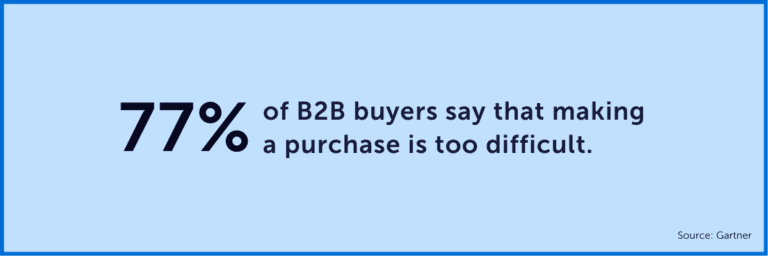The Customer-Centric Approach: A Sales Technique That Listens to People
March 21, 2022

The sales techniques so widely used today by salespeople over the world are the result of a process of constant evolution. Spin selling, solution selling, challenger sales… These days, there are all sorts of different ways of persuading customers to buy products and services. But being modern doesn’t necessarily make a technique an inherently good one or mean that it’s good for buyers.
Over the last few decades, there has been a growing emphasis on a more buyer-centered approach, with the dual aim of helping sales staff better understand the problem that needs solving and improving the overall customer experience. This is done by finding the answers to 5 questions, known as the ”Five Ws”, that allow digging deeper to uncover the real problems that are frequently hidden beneath those appearing on the surface and are often misunderstood by the organizations concerned. So, it’s hardly surprising that when salespeople don’t put customers first, there is a direct impact on their buying experience.
But What If the Art of Persuasion Just Isn’t Enough?
Modern approaches, such as value-based selling, for instance, seek to highlight financial impacts at all costs — be they positive or negative — in order to perform business analysis, justify the expected return on investment (ROI), and measure the real value of the problem that an organization is trying to solve. However, although it’s true that such approaches make it possible to go beyond what a product or service does, and make much more of the value it brings, some salespeople use this inside information to adapt their prices according to the customer perceived value.
For example, for the same geospatial software, a company for which the solution in question represents nothing more than an interesting addition to its teams could pay a much lower price than another company for which this same solution would be seen as key to achieving its objectives. As a result, the second company could end up paying more than the list price, simply because of its own perception of the software’s value.
That doesn’t stop some salespeople, who consider themselves to be masters in the art of persuasion, showing off their sales techniques and inundating potential customers with information that is not necessarily very useful, in an attempt to persuade them to buy a product or a service at a price that can occasionally seem outrageous. As a result, companies have to spend an average of 15% of their time demystifying the information provided by salespeople during the purchasing process.

Even if such skills do, in some cases, end up rewarding the salespeople and helping them to close their sales, it doesn’t mean that they are in any way listening to their customers or really hearing their needs. At the end of the day, of course, the losers in all this are the buyers, who have to put up with an unpleasant, stressful, and sometimes dishonest buying experience, just to find a solution to their problems.
Perfecting Sales Techniques Can Be a Long, Complicated Process
It usually takes sales reps years of practice before they really know how to make the “real value” of their product or service clear. Yet, because so few of them manage to really master these techniques, the various processes and “dances” involved in a sale are often poorly executed, which in turn damages the whole buying experience.
To mask their lack of experience, some salespeople even turn to pushier sales strategies in an attempt to achieve their ends, making customers feel cornered and with no option but to proceed with the purchase if they want the relentless onslaught to stop. Unfortunately, it is by no means unusual for an organization to be put through this kind of experience. According to Gartner, 77% of B2B buyers say that making a purchase is too difficult.

Consequently, as shown below, the more difficult the purchasing experience, the greater the risk of a customer regretting their purchase. Moreover, a lack of transparency on the part of a sales rep leads to a loss of trust between the two parties; again, this is something that directly impacts the customer experience.

Source: Gartner
Korem’s Customer-Centric Buying Journey
Fortunately, there’s now a new way of doing things: Korem’s sales strategy is based on a more human, more transparent, and more honest approach. We adapt our pace to suit everyone involved and we never attempt to pressure our customers into buying our products. As far as we’re concerned, selling isn’t about relentlessly pursuing a sale; it’s about putting yourself in the buyer’s shoes so that you can really understand their position and their point of view. Sometimes this means we even find solutions to problems they didn’t know they had or had never properly looked into before.
As geospatial is a highly complex, niche sector, the technology cannot be dissociated from the expertise Korem provides. Our experts in systems integration and value-added services are key to making the technology more accessible to customers. We are committed to guiding, educating, and informing them, right through the whole process of purchasing and integrating the technology, so that they are in a position to make more informed decisions about software and data. Consequently, when organizations decide to do business with us, it’s because they’re sure we have something valuable to give them and not because they feel obliged to buy.
The Old Way
- Difficult, stressful buying experience
- Profit-driven sales reps
- Impersonal and pushy service that lacks transparency
- Poor assessment of the value of the products or services
The New Way
- Customer experience focused on people and their needs
- Unique, personal approach
- Good understanding of the problems
- Negotiated price and conditions
At every stage of the customer journey, we do our utmost to ensure that they and their needs come first, with the sole aim of ensuring their success. Our growing collection of success stories stretches across a number of different sectors: insurance, retail, real estate, transport, telecoms, energy, and banking.
See what one of our loyal customers, direct mail company Mail Shark, has to say about Korem and the people working there:
“We’re thrilled with the product, but most of all, we’re thrilled about the people at Korem. One of Mail Shark’s core values is simply to be a good person, and Korem embodies that perfectly. Korem cares about the process, the people, and the results. It wants us to be successful as much as we want to be successful,” said Bryan Johnson, CEO of Mail Shark.
Why Do Business With a Reseller Rather Than a Supplier?
A customer-centric approach might look great on paper, but it also needs to be cost-effective for buyers. So, a lot of them wonder why they shouldn’t just buy a product directly from the supplier, thinking that, that way, they wouldn’t have to pay the extra costs billed by the reseller. However, contrary to popular belief, the added value proposed by a VAR like Korem doesn’t lie in the products themselves, but in the services and expertise that come with them.
With the constant advance of the geospatial technology industry and the ever-growing number of suppliers and products, it can be increasingly complicated for users to find their way around, particularly if they lack the necessary expertise to make the most of the technology. Because we are a data and software reseller with a vast network of partners, we are able to provide unbiased, agnostic, and rigorous service. In our business practices, we place great importance on negotiating the best prices and terms so that our customers do not have to do it themselves. By buying with us, they are sure to have access to the most suitable solution offering the best quality/price ratio on the market.
Being a smaller scale company, we are also able to offer a personalized approach to each of our clients. Unlike large corporations, who tend to see buyers as just a number that can generate profit for them, we like to see them as unique individuals with their own needs and use cases.
In short, with our unique, reinvented services offer, which includes strategic consulting, software asset management, outsourcing and enablement, and the integration of systems or managed services, we can accelerate an organization’s adoption of geospatial technology while managing any risks associated with its location projects. In other words, we allow our customers to buy smarter, easier and cheaper!
